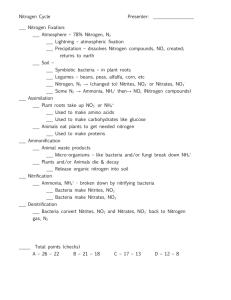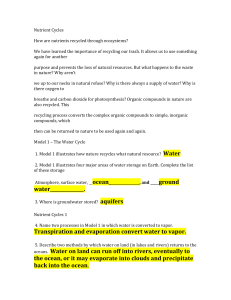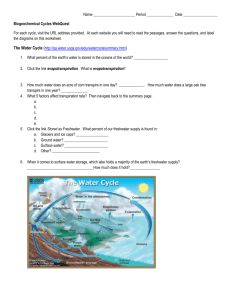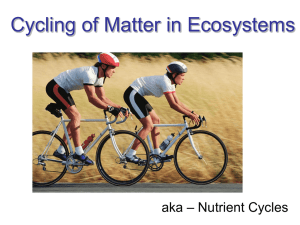Biogeochemical cycle webquest
advertisement
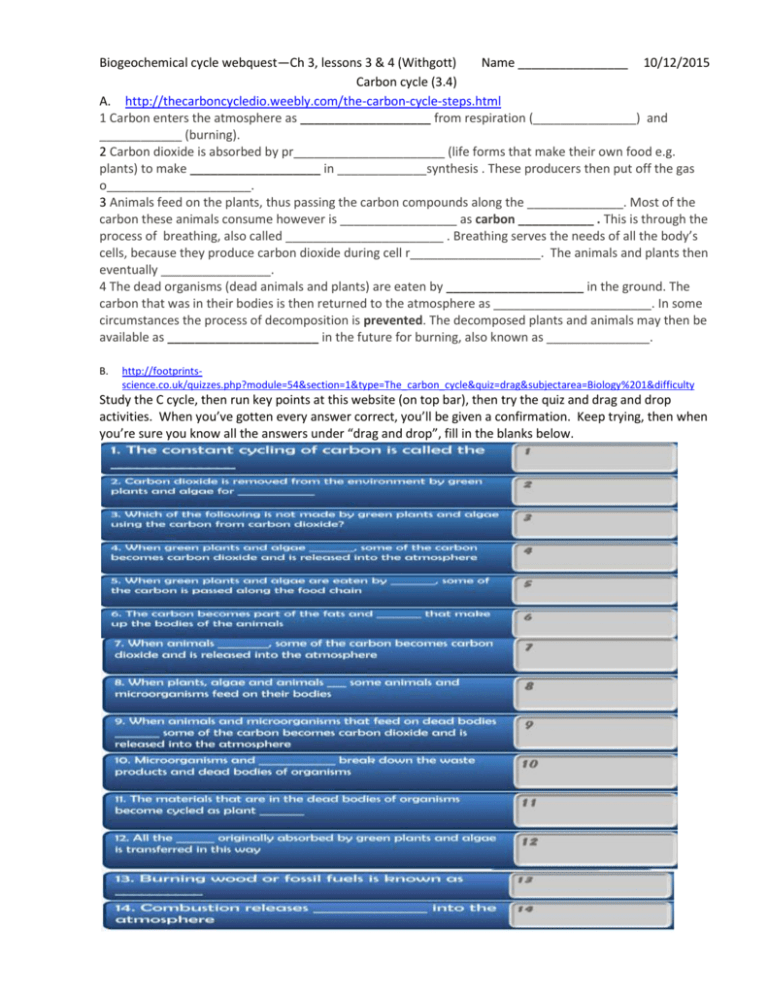
Biogeochemical cycle webquest—Ch 3, lessons 3 & 4 (Withgott) Name ________________ 10/12/2015 Carbon cycle (3.4) A. http://thecarboncycledio.weebly.com/the-carbon-cycle-steps.html 1 Carbon enters the atmosphere as ___________________ from respiration (_______________) and ____________ (burning). 2 Carbon dioxide is absorbed by pr______________________ (life forms that make their own food e.g. plants) to make ___________________ in _____________synthesis . These producers then put off the gas o_____________________. 3 Animals feed on the plants, thus passing the carbon compounds along the ______________. Most of the carbon these animals consume however is _________________ as carbon ___________ . This is through the process of breathing, also called _______________________ . Breathing serves the needs of all the body’s cells, because they produce carbon dioxide during cell r___________________. The animals and plants then eventually ________________. 4 The dead organisms (dead animals and plants) are eaten by ____________________ in the ground. The carbon that was in their bodies is then returned to the atmosphere as _______________________. In some circumstances the process of decomposition is prevented. The decomposed plants and animals may then be available as ______________________ in the future for burning, also known as _______________. B. http://footprintsscience.co.uk/quizzes.php?module=54&section=1&type=The_carbon_cycle&quiz=drag&subjectarea=Biology%201&difficulty Study the C cycle, then run key points at this website (on top bar), then try the quiz and drag and drop activities. When you’ve gotten every answer correct, you’ll be given a confirmation. Keep trying, then when you’re sure you know all the answers under “drag and drop”, fill in the blanks below. C. http://serc.carleton.edu/eslabs/carbon/6a.html Read through the information about the ability of the ocean to serve as a carbon sink, then answer the questions below. 1. Which areas of the ocean are absorbing more CO2 from the air? List all that apply cold northern oceans warm equatorial(tropical) waters cold southern oceans 2. Which general areas of the oceans have low amounts of CO2 diffusing into sea surface waters? Check all that apply. cold southern oceans cold northern oceans warm equatorial(tropical) water 3. True or False. Check the statements below that are true. More CO2 diffuses and dissolves in colder sea surface water and less CO2 diffuses and dissolves in warmer water Sea surface waters have become slightly warmer as the climate warms. If this continues, you would expect concentrations of CO2 in the atmosphere to decrease. D. http://www.sumanasinc.com/webcontent/animations/content/carboncycle.html Watch/listen to this animation, then complete the questions below. 1. This figure shows that most of the earth’s carbon is found in ___________________ and in marine _______________ & __________________. 2. True or False. The majority of C on earth has not been actively cycling for over 200 million years when deposited as either fossil fuels or marine sediments. 3. Most actively cycling C in terrestrial (land) ecosystem is released from soil microbes and other organisms (biota) via cell r______________. 4. 4. Two human activities resulting in the increasing concentrations of CO2 are ___________________________ & ____________________________. Before the industrial revolution initiated burning of fossil fuels, the equilibrium concentration of carbon dioxide in the atmosphere was likely about _____________ parts per million. 5 The line above is zig zagged because in winter, cell respiration’s replacement of carbon dioxide exceeds _______________ removal. 6 The reason climate scientists are concerned about increasing CO2 concentrations is that the earth tends to (?increase, decrease?) ________________ as they rise. Hence, CO2 is called a g_____________ gas. 8 9 10 11 7 Climate scientists are concerned warming of oceans might upset the ocean conveyer belt that now allows the CO2 removed by marine organisms like diatoms & foraminopherans to ___________________. 12 13 14 15 Increased CO2 warms the atmosphere, in turn inhibiting the ability of the North Atlantic to absorb CO2 & allow its sequestration into sediment, thus further raising CO2 concentrations and even further raising average global temperature. What type of feedback loop does this set of events demonstrate: Negative or positive? _________________ Nitrogen Cycle E. http://www.pbslearningmedia.org/asset/lsps07_int_nitrogen/ Run this animation to learn about the nitrogen cycle, then answer these questions. ________________ , ________ , & _______. 1 2 3 i Bacteria in soil or legumes ____ N to a form other organisms can use. __________ are plants w/ roots contain Nitrogen fixing bacteria. Nitrogen ___________________________. iii __________________ by other soil bacteria converts nitrates back into N2 gas. ii Animals & decomposers ________________ N out of proteins, DNA, & RNA in foods. By metabolism, they break food down proteins, DNA, & RNA, then rebuild their own according to their own genetic instructions 4 Humans farm the same soil repetitively, faster than nitrogen fixing bacteria can replace the nitrates required by plants. This requires the use of chemicals called f_________________ which are made artificially in chemical factories via an energyexpensive process called the Haber process. W/o fertilizer, yields of food per acre would be far lower. F. https://www.classzone.com/books/ml_science_share/vis_sim/em05_pg20_nitrogen/em05_pg20_nitrog en.swf Run animation, then answer questions below. 1 2 3 4 5 6 7 _________ via denitrification. F. http://www.wignallandwales.co.nz/NDSWB/Sample-files/6G1b--Nitrogen-cycle-diagram.htm Study the nitrogen cycle, then attempt to fill in the nitrogen cycle. When you’ve correctly identified answers, fill them into the chart below. a b 1 c 2b d 3 5 e 4 6 2a f 8 7 g h i G. https://www.superteachertools.us/jeopardyx/jeopardy-reviewgame.php?gamefile=34443#.Vhvp2uxVhHw 1 The _________________ _____________ is the movement of nitrogen between the abiotic & biotic factors within the environment. 2 __________________ ________________ is a bacterial process that is able to change N2 gas into forms (ammonium and nitrate ions) that producers like photosynthetic bacteria, plants, and algae can use. 3 Plants take fixed N, in the form of nitrate ions, out of soil to make _______________, _______ & _______. 4 Animals get their fixed nitrogen out of their __________________, like plants they ate. 5 An abiotic source of fixed nitrogen is ___________________ during storms. 6 ____________________ of dead organisms returns fixed nitrogen to the soil for reuse by plants. 7What percent of Earth's atmosphere is nitrogen gas? ____________ 8 __________________ in the roots of plants called legumes can fix nitrogen; other soil ___________________ carry out denitrification, returning N2 gas to the atmosphere. Phosphorous cycle H. http://www.sumanasinc.com/webcontent/animations/content/phosphorouscycle.html run the animation to learn about the phosphorous cycle 1. Two locations of P in all cells is genetic material ______________ and the phosphate heads of the phospholipids in the cell membranes. 2. The main reservoir (storage place) of P in the environment is in minerals that form ____________. 3. P cycles through marine organisms for _________________ of years before settling into sediments at the bottom of the ocean, forming a rock called limestone. 4. Weathering of rocks releases it for use by ____________________ which pass the P up to consumers, then decomposers, via the food web. 5. True or False. ________ The P cycle is a sedimentary cycle that does not include an atmospheric phase. I. https://www.lcmrschooldistrict.com/roth/PowerPoint_Lectures/chapter46/videos_animations/phos_ani m.html run to learn about the P cycle 3 1 2 3 4 6 5 1 7. True or False. ________ Excessive runoff of P from fertilizer used by humans can damage ocean and fresh water ecosystems by causing algal blooms. This is because N and P, both found in fertilizer, are the limiting factor for producer growth in both aquatic and terrestrial ecosystem. Water cycle www.educationsoutheastwater.com.au/game/natural-water-cycle.htm run to learn about the water cycle http://www.discoverwater.org/blue-traveler/ run to learn about the water cycle http://player.discoveryeducation.com/views/hhView.cfm?guidAssetId=087777c8-4ff0-45d2-878fe7cd90f7ee19



